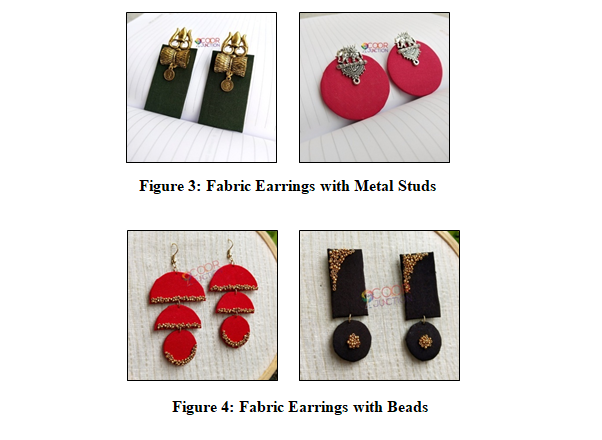Alleviation: An International Journal of Nutrition, Gender & Social Development, ISSN 2348-9340 , Volume 8, Number 8 (2021): 1-5
© Arya PG College (College with Potential for Excellence Status by UGC) & Business Press India Publication, Delhi
http://apcjournals.com, www.aryapgcollege.ac.in
Textile Jewellery – Recyling Trend
Vishruti Sharma
Guest Lecturer, Department of Home Science
Arya PG College, Panipat (Haryana), India
Email: sharmavishruti62@gmail.com
Abstract
Textiles have become an inseparable part of our lives in the modern world. Textiles are used in a wide variety of products, including clothing, home furnishings, jewellery, and décor. Currently, textile jewellery is in trend. Gems and precious stones have long been used in jewellery, but today jewellery is a fashion statement that enhances one's individuality. In the world of fashion, experimenting and adapting to new trends is perfectly acceptable. As for textile jewellery, it's both fashionable and eco-friendly at the same time. This jewellery is more interesting and one-of-a-kind because of the fabric reuse and the use of leftover fabric. Various textiles, prints, and patterns make it particularly appealing.
Keywords: Fabric Reuse, Style Statement, Jewellery, Accessories.
Introduction
Regardless of the occasion, jewellery is an essential part of accessories. No one can argue that jewellery enhances both the aesthetics of one's clothing and the personality of the wearer. fabric jewellery has been around since ancient times and is still popular today. Since time immemorial, people have used various materials to adorn their bodies, including bones, sea shells, stones, and animal skin. More and more materials have found a place in the world of fashion as ornaments.
These days, fabric jewellery is back in trend. Textile jewellery is another name for fabric jewellery. This type of jewellery is inspired by unique patterns and prints, which result in beautiful and eye-catching pieces of art. Beads, swarovski crystals, metal jhumki and any other type of decorative material can be used in textile jewellery. These materials enhance the artwork's aesthetic appeal while also fostering its originality. As a bonus, textile jewellery can liven up even the most boring and dull outfit. Moreover, it can also enhance one's personal style and coolness.
Usually we use fresh piece of fabric for any new project but textile jewellery gives us a chance to reuse old fabrics or leftover fabrics. It hardly matters that one is using a fresh running fabric or leftover fabric because no one can guess about the source of fabric. As a result, this is an excellent method for reusing fabric rather than throwing it away. It's possible to look stylish and unique at a fraction of the cost by wearing textile jewellery.
Characteristics of Fabric Jewellery
1) Any printed, colored, embroidered, embellished or textured fabric can be used.
2) Left over fabrics can be collected from tailors or boutiques and used in numerous ways.
3) Reuse of the fabric is main attraction of textile jewellery.
4) Surface ornamentation and surface embellishment gives a boom for styling of jewellery.
5) There aren't any restrictions on the clothing that can be worn with textile jewellery.
6) Textile jewellery can be worn by anyone, regardless of ethnicity or style.
7) Painting on fabric is fabulous in itself. While wearing this type of masterpiece, it makes the wearer center of attraction.
Methodology
Fabric jewellery construction or creation necessitates both patience and creativity. As long as we only use fabric and other materials, it's not that time consuming, but if we hand paint anything, it takes longer. Cardboard can be used as a base material for jewelry-making materials such as hooks, loops, studs, stoppers, small metal rings, and so on. The first step is to cut cardboard and fabric into the same shape. Fabric size should be larger than cardboard so that it can be folded and give finished look. Fabric glue is used for pasting fabric and for pasting metal pieces, metal pasting adhesives are used. Colors on a cotton base give a wide range of options, and the choice of motif is entirely up to the wearer. Look can be enhanced with tassels and thread beads. It's simple to demonstrate one’s adaptability and boundless imagination. There are a variety of materials and fabrics used.
Results and Discussions



Market Acceptability
Everyone wants to look unique and noticeable. This urge is satisfied by fabric jewellery, which completes the look of personality. People who are always looking for something classy and unique will undoubtedly fall in love with textile jewellery. This jewellery is readily available in jewellery stores because of its popularity. As online shopping is preferred, many brands and websites have textile jewellery collection. Prices vary depending on the design, material used, uniqueness and time consumed to create it. Brands also have varying prices. The versatility of textile jewellery means it can be worn with both Western and Indian traditional attire. As a bonus, fabric jewellery can be worn by women of all ages, and on any occasion
Conclusion
Creating textile jewellery is one of the best ways to reuse scraps of fabric. It's a novel idea to combine both usefulness and creativity in a single product. No wonder people purchase this collection and flaunt it as their way of expression. This piece of jewellery can be worn for any occasion or with any type of clothing. The versatility of fabric jewellery allows it to be worn with a wide variety of outfits and enhances any appearance. A piece of fabric jewellery is a form of art in and of itself.
References
www.pinteret.com
www.fiber2fashion.com
www.etsy.com

